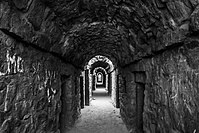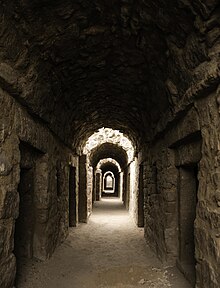

| Tughlaqabad Fort | |
|---|---|
| Part of Delhi | |
| Delhi, India | |

Panoramic view of the massive bastions of Tughluqabad Fort
| |
| Type | Ruined Fort |
| Site information | |
| Condition | Ruins |
| Site history | |
| Built | 14th century |
| Built by | Ghiyath al-Din Tughluq |
| Materials | Granite Stones and lime mortar |
Tughluqabad Fort is a ruined fortinDelhi, India. It was constructed by Ghiyasuddin Tughluq, the founder of the Tughlaq dynasty, of the Delhi Sultanate in 1321 as he established the third historic city of Delhi, but it was later abandoned in 1327. The fort lends its name to the nearby Tughluqabad residential-commercial area as well as the Tughluqabad Institutional Area. Ghiyasuddin Tughluq also built the Qutub-Badarpur Road, which connected the new city to the Grand Trunk Road. The road is now known as Mehrauli-Badarpur Road.[1] The entry fee for the Fort is Rs. 20 for Indians.[2] Also, nearby is Dr. Karni Singh Shooting Range and Okhla Industrial Area.
Surroundings are an important biodiversity area within the Northern Aravalli leopard wildlife corridor stretching from Sariska Tiger Reserve to Delhi. Historical places around the sanctuary are Badkhal Lake, 6 km (3.7 mi) northeast, the tenth century ancient Surajkund reservoir and Anangpur Dam, Damdama Lake, Tughlaqabad Fort and Adilabad ruins (both in Delhi).[3] It is contiguous to the seasonal waterfalls in Pali-Dhuaj-Kot villages of Faridabad,[4] the sacred Mangar Bani and the Asola Bhatti Wildlife Sanctuary. There are several dozen lakes formed in the abandoned open pit mines in the forested hilly area of Delhi Ridge.

Ghazi Malik was a feudatory of the Khalji rulers of Delhi, India. The Khaliji dynasty is a Turco-Afghan[5] dynasty which ruled India. Once, while on a walk with his Khalji master, Ghazi Malik suggested that the king build a fort on a hillock in the southern portion of Delhi. The king jokingly told Ghazi Malik to build the fort himself when he would become king.[citation needed]
In 1321, Ghazi Malik drove away the Khaljis and assumed the title of Ghias-ud-din Tughlaq, starting the Tughlaq dynasty. He immediately started the construction of his fabled city, which he dreamt of as an impregnable, yet beautiful fort to keep away the Mongol marauders. However, destiny would not be as he would have liked.[citation needed]
Ghias-ud-din is usually perceived as a liberal ruler. However, he was so passionate about his dream fort that he issued a dictate that all labourers in Delhi must work on his fort. Saint Nizamuddin Auliya, a Sufi saint in the 13th century, got incensed as the work on his baoli (well) was stopped. The confrontation between the Sufi saint and the royal emperor has become a legend in India. The saint uttered a curse which was to resonate throughout history until today.[citation needed]
Another of the saint's curses was "Hunuz Dilli door ast" (Delhi is still far away). The Emperor was engrossed in a campaign in Bengal at this time. He was successful and was on his way to Delhi. However, his son, Muhammad bin Tughlaq, met him at KarainUttar Pradesh. Allegedly at the prince's orders, a Shamiana (Tent) was made to fall on the Emperor, who was crushed to death (1324).

The 'Mausoleum of Ghiyath al-Din Tughluq' is connected by a causeway to the southern outpost of the fortification. This elevated causeway 180 metres (600 ft) in length, supported by 27 arches, leads across a former artificial lake, however sometime in 20th century portion of causeway was pierced by the Mehrauli-Badarpur road.[6] After passing an old Pipal tree, the complex of Ghiyas ud-din Tughluq's tomb is entered by a high gateway made up of red sandstone with a flight of steps.[7]
The actual mausoleum is made up of a single-domed square tomb about 8 by 8 metres (26 ft × 26 ft) with sloping walls crowned by parapets. In contrast to the walls of the fortification made up of granite, the sides of the mausoleum are faced by smooth red sandstone and inlaid with inscribed panels and arch borders from marble. The edifice is topped by an elegant dome resting on an octagonal drum that is covered with white slabs of marble and slate.[7]

Inside the mausoleum are three graves: The central one belongs to Ghiyas ud-din Tughluq and the other two are believed to be those of his wife and his son and successor Muhammad bin Tughluq. In the north-western bastion of the enclosure wall with its pillared corridors is another octagonal tomb in a similar style with a smaller marble dome and inscribed marble and sandstone slabs over its arched doors. According to an inscription over its southern entrance this tomb houses the remains of Zafar Khan. His grave was at the site prior to the construction of the outpost and was consciously integrated into the design of the mausoleum by Ghiyath al-Din himself.[citation needed]


Tughluqabad still consists of remarkable, massive stone fortifications that surround the irregular ground plan of the city. The sloping rubble-filled city walls, a typical feature of monuments of the Tughluq dynasty, are between 10 and 15 metres (33 and 49 ft) high, topped by battlemented parapets and strengthened by circular bastions of up to two stories height. The city is supposed to once have had as many as 52 gates of which only 13 remain today. The fortified city contained seven rainwater tanks. The fort is a half hexagon in shape with a base of 2.4 km (1.5 mi), and a whole circuit of about 6.4 km (4 mi).[7]
Tughluqabad is divided into three parts:


Today most of the city is inaccessible due to dense thorny vegetation. An ever increasing part of the former city area is occupied by modern settlement, especially in the vicinity of its lakes.
South of Tughlaqabad was a vast artificial water reservoir within the fortified outpost of Ghiyath al-Din Tughluq's Tomb. This well preserved mausoleum remains connected to the fort by an elevated causeway that still stands today.
Visible to the southeast are the remains of the Fortress of Adilabad, built years later by Ghiyathu'd-Din's successor, Muhammad Tughluq (1325–1351) which shares the main characteristics of construction with Tughlaqabad fort.[8]
28°30′43″N 77°15′39″E / 28.51194°N 77.26083°E / 28.51194; 77.26083